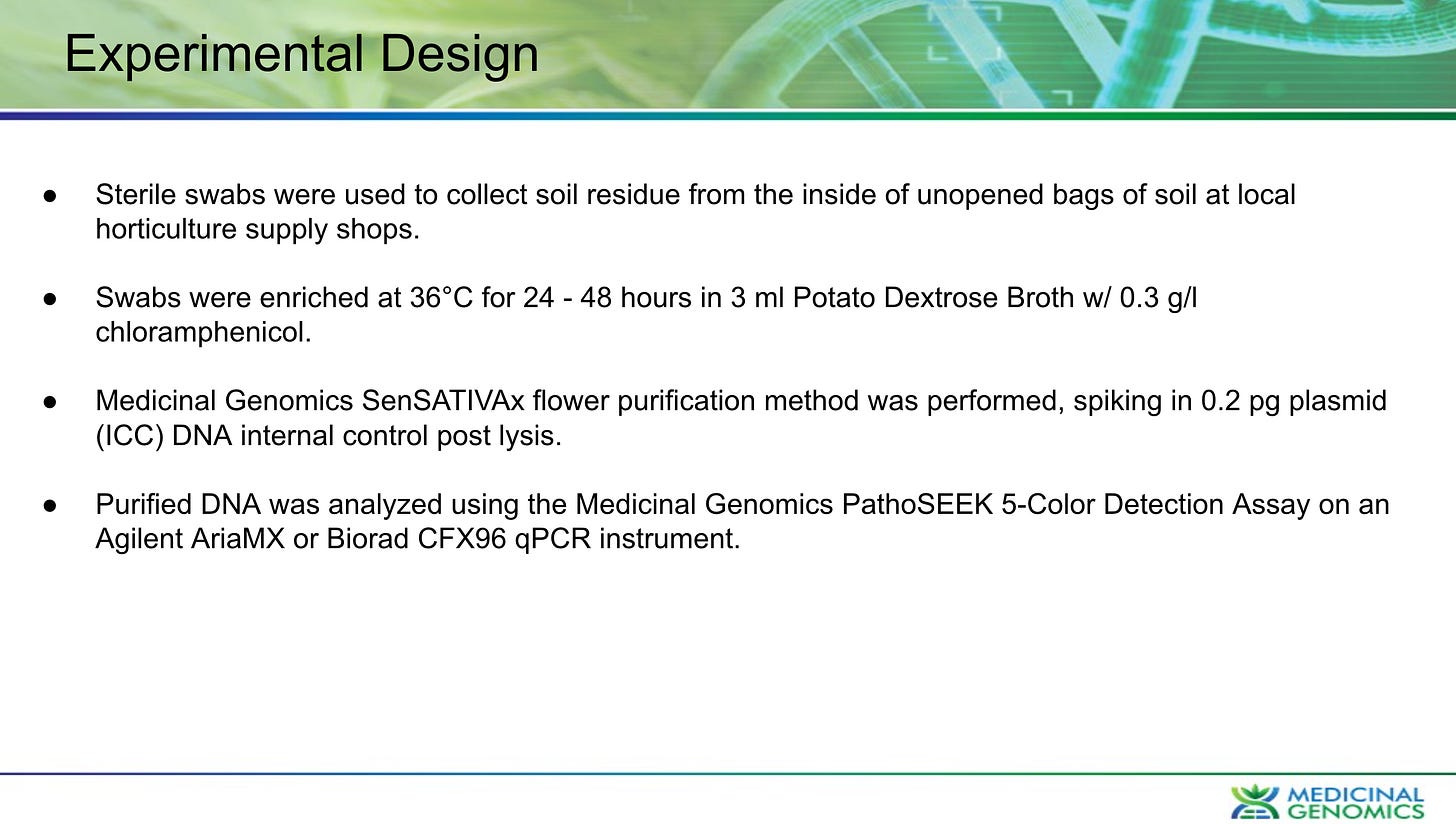Soil Testing for Aspergillus
qPCR can inform on sources of fungal contamination
Cannabis Soil Testing for Aspergillus
Matthew Brown, Yvonne Helbert, Kevin McKernan
Medicinal Genomics, 100 Cummings Center, Suite 406L, Beverly MA 01915
Abstract
Multiple jurisdictions have implemented Aspergillus testing for cannabis flowers due to the reported Aspergillosis cases from Cannabis users. Aspergillosis infections, while rare, can have a 50% fatality rate.
Many states that implement Aspergillus testing experience an initial high rate of crop failure as the industry attempts to resolve the source of the contamination revealed by the recently implemented and more stringent testing regulations. Some states like Oregon went as far as to abandon these tests under the grounds that Aspergillus was too hard to eliminate and the crop failure rate was costing the cannabis grows an excessive economic burden. The majority of the tax base in many state run cannabis commissions are from the growers, not the lab testing companies. As a result the growers have much more lobbying power than the few labs that exist in each state.
Other states like California and Colorado experienced high failure (5-20%) rate upon implementation of the guidelines (more prevalent in pre-rolls) but reduced failure rates (<4%) once sources of the contamination were identified and eliminated. These states have demonstrated that Aspergillus testing can reduce consumer exposure and that it is possible to grow Aspergillus free cannabis.
The CDC has published a report derived from Insurance companies that find 350% higher fungal infections in cannabis users. Aspergillosis and mucormycosis were the frequent ICD-10 codes cited.
Punja et al. has made note of certain cannabis genetics that consistently test higher for Total Yeast and Mold suggesting Aspergillus positivity may be dependent on the Cannabis genetics being grown. While genetics may help to limit the yeast and mold burden in cannabis, many environmental factors can contribute to the risk (Punja et al).
Results
In this study we surveyed 20 different soils sold at cannabis grow stores for Aspergillus fumigatus, Aspergillus niger, Aspergillus terreus and Aspergillus flavus.
Most soil providers were contaminated with Aspergillus fumigatus. The CT scores varied from CT 17 to CT 28 or 2,000 fold in Aspergillus fumigatus content. 10% of the soil providers tested (2/20) were clean of all Aspergillus.
One plant (Elvis) was qPCR positive for Aspergillus fumigatus in the soil and subsequently in the flowers harvested. A second plant (Jamaican Lion) was qPCR positive in the soil but provided clean flowers. The Jamaican Lion plant has undergone extensive RNA-Seq and Iso-Seq (PacBio) across multiple tissues. Its most highly expressed genes are chitinases. It is known to be PM resistant but susceptible to Botrytis. It has never tested positive for Aspergillus in our experience with it.
Discussion
While these data demonstrate a high prevalence of Aspergillus fumigatus in various commercial soils, the Aspergillus content varied substantially according to qPCR. More work is required to understand the minimal infective dose of soils with varying Aspergillus content and how this minimum infective dose may vary with various cannabis cultivars. Soil providers do exist that are Aspergillus fumigatus free according to this limited sampling.
There are sampling limitations to this study. Cotton swabs only survey a small amount of material from a soil sample and future studies would benefit from increased sampling and a correlation with soil Aspergillus content and Aspergillus content in cannabis flowers grown in such soils.
qPCR screening of soil providers may assist in lowering cannabis cultivators failure rate for various pathogens. Punja et al demonstrate the genetics of the plant cannot be ignored. This is supported by this limited study.
Hass Doris, Lesch Susanne, Buzina Walter, et al.: Culturable fungi in potting soils and compost Medical Mycology, Volume 54, Issue 8, November 2016, Pages 825–834
Shelton Jennifer M. G., Collins Roseanna, Uzzell Christopher, B. et al: Citizen Science Surveillance of Triazole-Resistant Aspergillus fumigatus in United Kingdom Residential Garden Soils https://journals.asm.org/doi/10.1128/aem.02061-21
Spikes Sara, Xu Ran, Nguyen Kim C. et. al.: Gliotoxin Production in Aspergillus fumigatus Contributes to Host-Specific Differences in Virulence
The Journal of Infectious Diseases, Volume 197, Issue 3, 1 February 2008, Pages 479–486, https://doi.org/10.1086/525044
Dagenais Taylor, R, Keller Nancy P.: Pathogenesis of Aspergillus fumigatus in Invasive Aspergillosis
Clin Microbiol Rev. 2009 Jul; 22(3): 447–465. doi: 10.1128/CMR.00055-08 PMCID: PMC2708386 PMID: 19597008











I wonder about the natural soil just outside your house. It probably has fungus also. Seems natural soils will have all kinds of fungus.
Does this affect edibles?